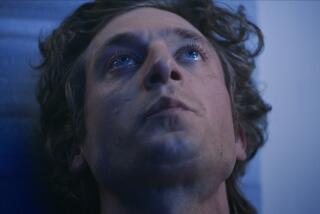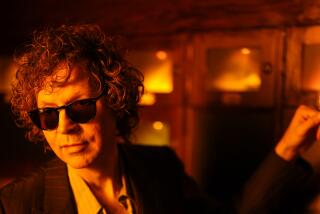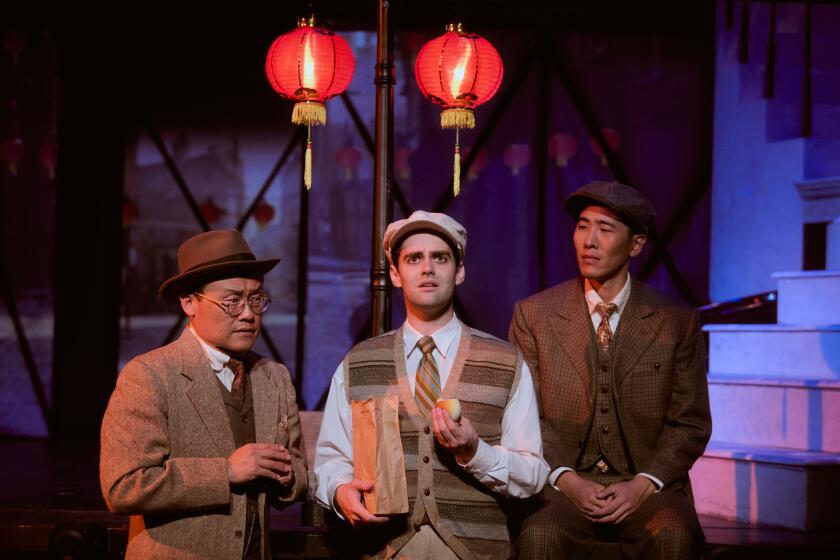A Place of Her Own : Culture: Francoise Gilot, Picasso’s former lover and Jonas Salk’s wife, wants to be known not as the companion of great men, but as their equal.
Picasso wasn’t the first.
Years before Francoise Gilot had even met Picasso, there was someone else. Sure, her name would be linked to the crusty Spaniard’s long after her tempestuous years as his mistress. But Picasso did have a predecessor and Gilot remembers spotting him from the rarefied height of her grandmother’s staircase in Paris.
“It was the first of January, and my grandmother had a kind of salon, and that day there were some friends of my grandmother who came. All of a sudden, someone arrived. He was called Emile Mairet. He was a post-Impressionist painter. He was dressed all in black. I remember because it was so stunning, a black hat with a large brim. He was wearing a rather high collar and a lavaliere, the kind of tie that only the artists would wear. And he had a huge black cape. He was dressed almost like Whistler.
“He was in his 60s probably, but he was the most handsome man. He was bringing a huge bouquet-- c’etait de la mode de la violettes de Palmes --the violets from Palma which are the pale violets, and he really cut a fantastic figure.
“When everybody left, I said to my grandmother, ‘Who was that man?’ And she said, ‘Ah, you noticed, but he is an artist.’ And when my grandmother said that, she meant everything--’ Ah, mais oui, c’etait un artist! ‘ And I answered right away, ‘ Ah, moi aussi ‘ (Me too).”
She was 5 years old.
If Francoise Gilot considers herself a handmaiden of fate, as biographers say, then destiny showed her its own hand particularly early on. And if Gilot has found a degree of double-edged fame because of her relationships--first with Picasso, and now as the wife of Dr. Jonas Salk--her first consort was always art.
She enjoyed entree to some of the finest minds of the 20th Century, and as a witness to it all, her remarkable memory has served her well. The woman who remembers the precise shade of violets a man was carrying nearly 65 years ago has also reconstructed numerous conversations between two of the titans of modern art in her latest book of memoirs, “Matisse and Picasso: A Friendship in Art” (Doubleday). The book is a collage of recollections and analysis of their art and friendly rivalry, particularly in the years when their lives intersected with hers--from 1946 to 1954.
“I don’t write diaries and things like that,” says the sometime-La Jolla resident, “but I have a fantastic memory. I call that like a magic carpet. I can really concentrate and travel back in the past I don’t know how many years from now and evoke that space if I wanted.”
While the public’s fascination with Gilot stems largely from her intimate relationships with two great men--a source of great annoyance for her--she would prefer to be thought of not as their significant other, but as their equal. In fact, when Gilot, 69, was once asked how she had attracted them, she replied: “I think I am just as interesting as they.” She recently told Mirabella magazine: “Lions mate with lions. They don’t mate with mice.”
Indeed, Gilot proudly considers herself no mere mouse spouse--but a disciple and scribe on the order of the Greek philosophers.
She says her writing “ ‘Matisse and Picasso’ is a little like Plato after Socrates. Socrates only taught in words. He didn’t write. And after that you had Plato and Aristotle to write about what he had said.
“I write about them because they didn’t write about them.”
A touch of irony helped spark Gilot’s writing career. While she and Picasso were together--they met in 1943--Picasso would beg her to write articles about him for the French press. At the time, Gilot demurred, figuring that if she couldn’t speak the whole truth as she saw it, she wouldn’t speak at all.
But Picasso, who adored the limelight, eventually got his wish--much to his dismay. In 1964--a decade after she walked out--her book “Life With Picasso” was published. The sometimes scathing memoir sent a stake into the heart of his deified reputation. In a bid to stop publication, Picasso sued twice, both times unsuccessfully.
And it was obvious to see why he tried: Gilot’s Picasso was brilliant, yes, but as destructive as he was creative. He was a man whose bursts of violent temper, cruelty and capriciousness burnt a swath of misery among the people close to him. In one telling anecdote, Picasso “branded” Gilot by holding a cigarette to her cheek for committing the crime of enjoying a seaside furlough without him. And those were the good old days.
To this day, Gilot bristles when people talk about Picasso with reverence. It’s true that she too was awed by the artist, who was already famous and 40 years older than she, when they met at a Paris restaurant. But even early in their relationship, Picasso’s dark side was apparent. He once showed her a pile of dust in his studio and said, “You don’t count any more for me than that dust there,” she eventually made good on her quick rejoinder: “The difference is that I’m the kind of dust that doesn’t like being swept out--the kind that will leave when it wants to.”
She stayed in the relationship because Picasso was, well, Picasso. “At the time I went to live with Pablo,” she wrote, “I had felt that he was a person to whom I could, and should, devote myself entirely, but from whom I should expect to receive nothing beyond what he had given the world by means of his art.”
But when Gilot made the break, it was certainly a clean one.
After the artist’s death in 1973, Gilot made no claims on his artwork. (Her children Paloma, the socialite-designer, and Claude, who has flirted with photography and rug design, however, inherited numerous artworks when they each secured a tenth of his $260-million estate.) In fact, she considers dumping the one Picasso she did own--her own portrait, “La Femme-Fleur”--one of her smartest moves. She sold it in the early ‘80s.
“I decided at one point I would sell that painting because everything linked to him has produced anathemas and bad luck to everybody. I don’t want to have anything tangible that remains from him. More than bad luck, he really brings death to a lot of people. After all, two of his women committed suicide. His grandson committed suicide.
“So there is a very black shadow around that. People don’t understand that. But for me, it’s a thing that was very tragic and can have a terrible connotation and I wanted to be free of that. I’m not a fanatic and I’m still quite objective and I can like his work, but I want to be removed from it, except as a writer. That’s my prerogative, of course.”
Gilot is glaring as she delivers this particular gauntlet. She is sitting on a brocade couch at the tony California Club in downtown Los Angeles and she is clearly irritated. She is the picture of elegance in a red suit, cream silk blouse and chunky gold jewelry. And the face whose sharp angles inspired Picasso’s artistic vision is still handsome, her eyes a piercing shade of smoke blue. Piqued, her eyebrows lift into the sharp circumflex accents Matisse once described.
But while Gilot still writes about the Picasso era, lo those many years later, she doesn’t like to be asked about it.
Gilot’s antipathy toward the press has a long history. In “Life With Picasso,” she writes that journalists tried to lie and bribe their way into her hospital room to photograph her newborn Paloma. And when she and Picasso had begun drifting apart, with the artist off gallivanting from affair to affair, Gilot watched her relationship crumble in the titillating pages of the French press.
“I think one of the reasons why living with Picasso became unbearable is because I had no privacy and that is impossible. If you are not a goldfish, you don’t want to live in an aquarium.”
Salk was similarly inclined to stay on dry land, and the couple, who met through mutual friends in La Jolla in the summer of 1969, have gone to great lengths to ditch the press. Their successful intrigues are still a source of great amusement to Gilot.
She talks about one evening at New York’s “21” Club a mere two weeks before her marriage to Salk in 1970. The two went so far as to dine at different tables, pretending not to know each other “since we didn’t want the journalists to be after us.”
“And we left very rapidly for Paris, because it was in Paris we got married to not have the rush of journalists there.”
They flew to Paris as Mr. and Mrs. Peterson, and did the deed five days earlier than their announced date. Even Gilot’s children didn’t know about the marriage until it was a fait accompli.
These days, because the Salk Institute and its inspiration are located in La Jolla, Gilot lives there for two months in the winter and two in the summer. (The rest of the year she divides between New York and Paris.) In La Jolla, the couple live in a simple low-slung house with a spectacular view of the Pacific, although given her druthers, Southern California would not be among Gilot’s roosts.
“If not for my husband, I would not spend five minutes in La Jolla,” she says.
Beyond that, Gilot will say nothing about her life with Salk, the celebrity doctor who is credited with discovering the polio vaccine and is working on an immunogen for AIDS. Salk, however, who rarely gives interviews, did speak warmly of his wife: “She’s truly a remarkable human being--her intelligence, her compassion, her wisdom, her talent. She’s one of the most highly evolved people I know.”
Gilot once told a reporter: “In Jonas Salk, the man is equal to the artist. Picasso, the man, was not on the same level as Picasso, the artist.” But now her hackles rise again at the prospect of making such comparisons.
“With Jonas, we prefer to be private even though we have a public life, so we are public as far as our public life is concerned and no more than that, and we are entitled to our privacy. With Picasso it was different. He was visible from everywhere, then it’s fair game.”
Gilot has reason to be ambivalent about public life. When she left Picasso--his only serious companion to do so despite his grand riposte, “No woman leaves a man like me”--he put the worst possible face on it.
“You imagine people will be interested in you ?” Picasso said as they separated. “They won’t ever, really, just for yourself. Even if you think people like you, it will only be a kind of curiosity they will have about a person whose life has touched mine so intimately .”
And despite Gilot’s own accomplishments as an exhibiting painter and writer--just last year she was inducted into the French Legion d’Honneur, one of only a handful of women to be so honored--Picasso’s caveat has at times been borne out.
“I think she will go down in history as one of the good artists, but unfortunately it’s been hidden because of her associations,” says her La Jolla art dealer, Mary Riggs. “I think people are blinded by it.”
In fact, Gilot’s dedication to art long predated the artist. Young as she was when she met Picasso, she was already an exhibiting artist herself. She was born into a cultured family in Paris, the daughter of an agronomist and businessman who made colognes for Christian Dior. Gilot’s father, whose difficult and demanding nature would be echoed in Picasso’s, insisted she study law. Her mother, a watercolorist, trained Gilot as the artist the girl yearned to be.
In May, 1943, Gilot met Picasso at a restaurant when he came to her table to offer her a bowl of cherries. Three years later, Picasso persuaded a reluctant Gilot to move in with him.
Picasso liked Gilot to be pregnant “because I wasn’t enough of a woman,” she wrote. Yet once she had given birth to Claude and then to Paloma, Picasso was averse to lying in the exceedingly domestic bed he had made.
“He had directed this metamorphosis in my nature, and now that he had achieved it, he wanted no part of it,” she wrote.
Picasso used cruelty as a wedge. When Gilot was about to give birth to Paloma, Picasso insisted their chauffeur take him to a conference before delivering her to the hospital.
Ultimately, Picasso--who liked to say there were only two kinds of women, goddesses and doormats--learned that Gilot was no doormat. She left him in 1954 and fought for years to see that her children received their fair inheritance despite the fact that she and Picasso were never married (he was still married to his first wife, Olga, while he was living with Gilot). After she left Picasso, he declared her his sworn enemy, meanwhile fostering the dependence of her predecessors Marie-Therese Walter and Dora Maar by giving them allowances.
By a fanciful measure, Gilot likes to quote the philosopher Emmanuel Berl’s mischievous remark “that Picasso and I had joined our destinies because we were both in love with Matisse’s art and that we separated as his death became imminent.”
Gilot describes Matisse and Picasso as admiring rivals and sometimes testy friends whose artistic competitiveness and compatibility could come together in their respective relationships with Gilot. Gilot tells of her first meeting with Matisse at his Vence villa in 1946.
Mindful of Matisse’s colorist’s eye, she dressed in hues to please--almond-green slacks and a mauve top. Gilot immediately hit her target. She writes, Matisse “at once stated that he might very well make a portrait of me, in which my hair would be olive green, my complexion light blue, and in which of course he could not forget the angle of my eyebrows in relation to my nose.”
Picasso, who hadn’t yet done any portraits of Gilot, was appalled that Matisse should suggest doing one himself. And with his competitive back up, he painted his own portrait of Gilot as a flower, “La Femme-Fleur”--with green hair and blue complexion, just as Matisse had envisioned her.
“Matisse’s appreciation of me acted like a visa on my passport to the realm of art!,” Gilot writes. “Pablo began clinging to me; he was now adamant that I should share his life.”
Maurice Tuchman, senior curator of 20th-Century art at the Los Angeles County Museum of Art, says Gilot was among Picasso’s most important companions (all told, there were half a dozen wives and serious mistresses as well as four children). She was “a central force in his life for years,” he says. “He was open and expressive with her, and he flourished as an artist with her. And she was a vibrant love object, as he liked in women, but beyond that he found her extremely intelligent, and that wasn’t always the case with his women.”
Two years after she left Picasso, Gilot married another painter, whom she refers to as her second husband, even though she and Picasso never wed. They had a daughter, Aurelia, who works for the San Diego City Planning Council.
And if those years and the ones to follow were stocked with an unusual quantity of compelling moments, then Gilot figures she can thank a heady mixture of fate and steely will.
Muses the muse: “You are selected and you select each moment. You select that road rather than that one, that friend rather than that one.”
More to Read
The biggest entertainment stories
Get our big stories about Hollywood, film, television, music, arts, culture and more right in your inbox as soon as they publish.
You may occasionally receive promotional content from the Los Angeles Times.






